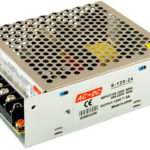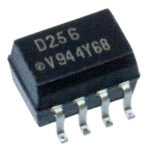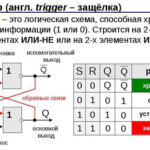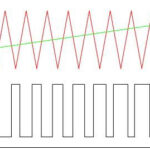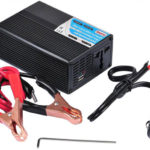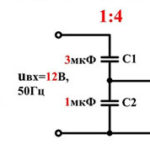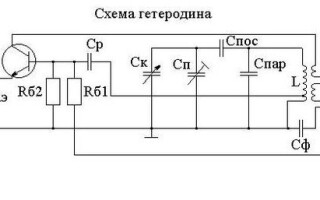Heterodyne (oscillator) in a receivertransmitterIn most cases the signal generator that determines the frequency of the reception is called a heterodyne. Although its role is called auxiliary, it has a very significant impact on the quality of the receiving or transmitting device.
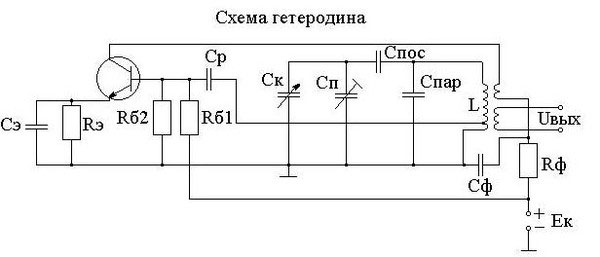
Contents
Heterodyne function and principle of heterodyne reception
In the early days of radio reception, all radio receivers were designed without a heterodyne. The signal picked up by the oscillating input circuit was amplified, then detected and fed to a low-frequency amplifier. With the development of circuitry, the problem of building a high-gain radio frequency amplifier arose.
To overlap a large range it was made with a wide bandwidth, which made it prone to self-excitation. Switchable amplifiers turned out to be too complicated and cumbersome.
That all changed with the invention of heterodyne reception. The signal from a tunable (or fixed) oscillator is fed to a mixer. The other input of the mixer is the received signal, and the output is a huge number of Raman frequencies, which are the sums and differences of the frequencies of the heterodyne and the received signal in various combinations. Practical applications usually have two frequencies:
- f-heterodyne-f-signal;
- f-signal - f-heterodyne.
These frequencies are called mirror frequencies in relation to each other. Reception is carried out on one channel, the second is filtered by the input circuits of the receiver. The difference is called the intermediate frequency (IF), its value is chosen when designing a receiving or transmitting device. The other combinational frequencies are filtered out by the intermediate frequency filter.
For industrial equipment there are standards for selecting the IF frequency. In amateur equipment, this frequency is selected from different conditions, including the availability of components to build a narrowband filter.
The intermediate frequency selected by the filter is amplified in the IF amplifier. Since this frequency is fixed and the bandwidth is small (2.5...3 kHz is sufficient for voice information), the amplifier for it can easily be made narrowband with a high gain.
There are circuits that use the total frequency - f-signal + f-heterodyne. Such circuits are called "up-conversion" circuits. This principle simplifies the construction of the receiver input circuits.
There is also a direct conversion technique (not to be confused with direct amplification!), in which the reception is carried out almost at the heterodyne frequency. This circuitry is simple in design and tuning, but direct conversion equipment has inherent drawbacks that noticeably degrade the quality of performance.
Heterodynes are also used in the transmitter. They perform the inverse function of carrying a low-frequency modulated signal to the frequency of transmission. There can be several heterodynes in communication equipment. Thus, if a circuit with two or more frequency conversions is used, two or more heterodynes are used respectively. The circuit may also include heterodynes, which perform additional functions - restoration of the carrier suppressed during transmission, formation of telegraphic parcels, etc.
The power of the heterodyne in the receiver is small. A few milliwatts in most cases is enough for any task. But the heterodyne signal, if the receiver circuitry allows, can leak into the antenna, and it can be received at a distance of several meters.
There is a popular story among radio amateurs that in the days of the ban on listening to Western radio stations, representatives of the special services used to go around the entrances of houses with receivers tuned to the frequencies of "enemy voices" (corrected for an intermediate frequency). By the presence of signals, it was supposedly possible to determine who was listening to banned broadcasts.
Requirements for heterodyne parameters
The main requirement for a heterodyne signal is spectral purity. If the heterodyne produces a voltage other than sinusoidal, additional Raman frequencies are generated in the mixer. If they fall within the bandwidth of the input filters, it leads to additional channels of reception, as well as to the appearance of "hit points" - at some frequencies of reception there is a whistle that interferes with the reception of a useful signal.
Another requirement is the stability of the output signal level and frequency. The second is especially important when processing signals with a suppressed carrier (SSB (OBP), DSB (DSB), etc.) Continuity of the output level is easy to get by using voltage regulators to supply the master oscillators and the correct choice of mode of the active element (transistor).
Frequency constancy depends on the stability of the frequency reference elements (capacitance and inductance of the oscillating circuit), as well as the constancy of the mounting capacitance. The instability of the LC elements is mostly determined by the temperature change during the operation of the heterodyne. To stabilize the circuit components, they are placed in thermostats or special measures are taken to compensate for the temperature drift of the capacitance and inductance. Inductance coils are usually tried to be fully thermostable.
For this purpose special constructions are used - coils are wound with a strong wire tension, turns are filled with compound to exclude displacement of turns, wire is burnt into a ceramic frame, etc.
To reduce the effect of temperature on the capacity of the reference capacitor, it is made of two or more elements, selecting them with different values and signs of temperature coefficient of capacitance so that they are mutually compensated by heating or cooling.
Because of thermal stability problems, electronically controlled heterodynes, which use varicaps as capacitance, are not widely used. Their dependence on heating is non-linear, and it is very difficult to compensate. Therefore, varicaps are used only as detuning elements.
The capacitance of the assembly is added to the capacitance of the reference capacitor, and its instability also leads to frequency drift. To avoid mounting instability, all heterodyne elements must be mounted very rigidly to avoid even minimal shifts relative to each other.
A real breakthrough in the construction of master oscillators was the development in the 1930s of powder casting technology in Germany. This made it possible to produce complex three-dimensional forms for radio components, which made it possible to achieve an unprecedented stiffness of assembly at that time. This brought the reliability of Wehrmacht radio communication systems to a new level.
If the heterodyne is not tunable, the frequency hopping element is usually a crystal oscillator. This allows for an extremely high stability of the oscillation.
In recent years there is a trend to use digital frequency synthesizers as heterodynes instead of LC oscillators. The stability of the output voltage and frequency is easy to achieve, but the spectral purity leaves much to be desired, especially if the signal is generated using inexpensive microchips.
Today old radio reception technologies are being replaced by new ones, such as DDC - direct digitization. The time is not far off when heterodynes in receiving equipment will disappear as a class. But it won't happen anytime soon, so the knowledge of heterodyne and the principles of heterodyne reception will be in demand for a long time to come.
Related articles:
